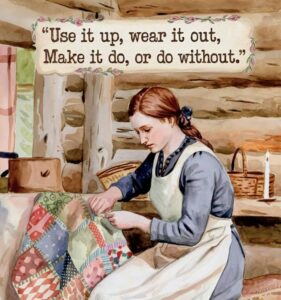There’s a mindset, these days, that everything is disposable. If something breaks, just get another one. Toss the old one in land fill and ignore it. This is not a sustainable practice.

Why did we become the strongest country in the world? We made do. We took everyone else’s outcasts, people who wanted to work and were motivated to become citizens, and we said “let’s do this.” Those people, coming into America, were coming here to become AMERICANS. They didn’t come to be African Americans or Cuban Americans or Chinese Americans or Polish Americans. They came here to be Americans, plain and simple. They came here because America provided (and still provides) a place for hard work and sacrifice to pay off in the creation of strong family and safe home.
Use It Up
If you buy something, use it up. It seems simple when you say it that way, but I have to ask you, how many times have you allowed that cabbage or bit of leftover stew in the back of the fridge until it turned into something approaching sentience? Too often, I’d wager. I’m bad at it myself, frankly. This is a basic thing that Grandma would have wanted you to know, though. If you’re in doubt, ask yourself: would Grandma be disappointed in me for doing this (or not doing it, as the case may be)?
Learn to turn little bits of leftover vegetables into something new. Learn how to make stews and soups. Learn how to dehydrate and can. Learn how to compost, too. If you have animals like chickens or goats or pigs, feed things to them rather than putting them in the trash. Make certain that every bit of food you purchase is actually eaten or preserved in some way.
This is how we end up with scrap quilts, by the way. When you buy (or thrift) fabric for clothing (or sheets or towels, or whatever), you will almost always be left with a handful of scraps. Sometimes they may be tiny, because you’ve patterned extremely well, and you can congratulate yourself. Still, stash away those scraps. They can be used to patch up clothing or sheets, or to fill holes in jeans. When you have enough scraps of whatever size, you cut them into a lovely pattern of squares or hexes or triangles, and now you have a quilt. Our grandmothers turned their leftover bits and pieces into huge sheets of stitched love that are now passed down from generation to generation. You, too, can do that.
Wear It Out
If you have a pair of shoes, wear them until they fall apart. It might be that, near the end of their life, you tape them up and use them when mowing the lawn. That’s okay. They’re still in use. Don’t be afraid to tape or glue things. Or mend them in some other way. The same goes for shirts, jeans, even underwear. When your tightie whities finally become holey enough that they’re no longer useful for stashing your trouser snake, take them out to the shop and use them to clean up oil spills or polish silver. Everything should be used, used again, and used until it turns to lint or dust.
There’s a propensity in today’s world to simply replace a shirt that gets a stain or a tiny rip. Don’t give in to that way of negative thinking. Learn to embroider, or buy a patch, or make a patch. Cover the stain or rip, and make your shirt usable AND pretty.
Make It Do
You’re in the middle of a recipe and realize you forgot to buy limes. It’s not the end of the world; use the bottled lime juice you almost certainly have in the door of your fridge. Perhaps your bedroom is an ugly shade of brown and you wish you had nicer items. Instead of dwelling on the imperfections, consider the fact that you HAVE a bedroom, and a bed, and soft sheets, and a pillow, which is more than half the world does.
Learn how to make every scrap scream for mercy. When it comes to leftovers, learn how to turn “freezer scrapings” into soup, and flour and water into bread. Old bedsheets can become a fun new skirt for her or a shirt for him. Ripped towels turn into rags for washing floors, OR you can learn how to turn them into rag rugs.
Make your purchases stretch. As an example, I use Dr. Bronner’s liquid soaps a lot of the time. I love the peppermint, but it’s a wee bit harsh on the girl bits, so I’ve switched to the tea tree hemp one. It smells nice, it’s non-toxic, and it can be used for EVERYTHING. Need to wash your face? Dr. Bronner’s. Need to wash dishes? Dr. Bronner’s. Need to scrub the kitchen floors? Dr. Bronner’s. Need to brush your teeth? Dr. Bronner’s. Need to do a load of laundry? Dr. Bronner’s. I’m serious, it’s useful for pretty much every cleaning need outside of toilets and tubs (it isn’t gritty enough, though I suppose you could mix it with baking soda and make scrub for toilets and tubs). What that means is you are purchasing one item instead of several, and it’s meant to be diluted before use. For instance, for cleaning items like stoves or floors, dilute 1/4 cup of Dr. Bronner’s and 4 cups of water, mix gently, and then scrub away.
Yes, it’s nice to be able to pop down to the Dollar General and grab any last minute needs, but what if you couldn’t? You should learn how to make do NOW, before it’s an emergency.
Do Without
This is the hardest one. If you don’t have the money for it, you have to do without. That means no sneaking and paying for it on the credit card. No getting a payday loan. If you want something, you have to save up for it. Do NOT spend money that isn’t there. Look at what you have and decide if you truly need whatever the new thing is. It’s quite likely the answer is no. On those rare occasions you do actually have a need, rather than a want, for something then go ahead and get it. But pay cash or go without.
While you’re at it, consider what you’d do if there was no way to replace items that got worn out or otherwise destroyed. What if the end of the world came, and you couldn’t use your washer and dryer. Could you clean your clothing and sheets? Do you know how to wash and rinse and dry household items without a washer? Do you know how to safely store food without a fridge and freezer? Can you clean a wound and patch it up?
Now is the time to think about how one “goes without” necessities. Waiting until everything is gone is a bad answer, and a final one.
In Conclusion
If you are poor (or know people who are poor), check out this guy @zielzebub on TikTok. He runs a series of videos called Poor for Dummies, and it’s fantastic. He’s not putting up with people’s excuses, and he’s young and hip enough (or whatever terminology they’re using these days) that the more youthful viewers can relate to him. I adore his videos and they’re practical and food-minded. 🙂
If there are “making do” things you’d like me to talk about, PLEASE comment below.


With a lot of food that I buy packaged in “ziplock” packaging or plastic bags, I don’t buy kitchen garbage bags. I repurpose the packaging for garbage and full them full. Works for me. I also wear clothing to the rag stage, there’s a “rag drawer” where old clothing and towels go when they are no longer useful for the intended purpose.
Speaking of gritty soap: I once had a nasty case of poison ivy and was told to get a tube of some staff to scrub it. It helped somewhat, but it’s quite expensive. Forgot the name, starts with Z. Zantec? Or is that the allergy pill.
Anyway, some searching pointed me at a substitute that’s nearly the same ingredients and works well: “Mean Green” soap. That stuff comes in a pound jar, or bigger, for a few bucks. It apparently was invented for pressman to scrub ink off their hands, but it also works for other kinds of bad sticky crud like the old grease on your tractor.
Zanfel? Is that the poison ivy cream you mentioned?